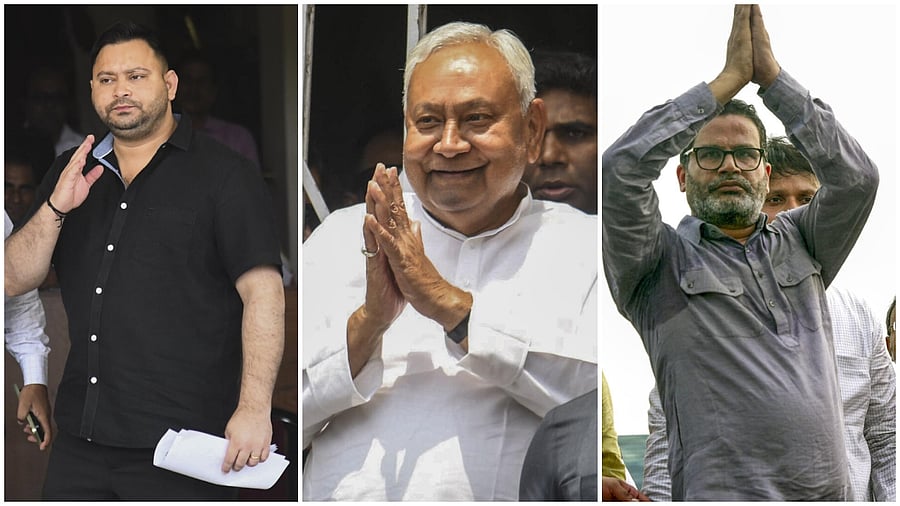
RJD leader Tejashwi Yadav (L); Bihar CM Nitish Kumar (C); and Jan Suraj Party leader Prashant Kishor.
Credit: PTI Photos
As the Bihar Assembly elections near, a familiar word is reverberating across political platforms and between party lines: ‘Bihari Asmita’. It was once conjured in the context of ancient glory, moral superiority, and mass movements typical of Bihar; it is now being reimagined against the backdrop of contemporary crises: economic stagnation, mass migration, and the collapse of confidence in public institutions.
But is this a genuine socio-political revival, or is ‘asmita’ just another jibe, whose shape and size have changed to suit new electoral realities?
Reclaiming asmita
Bihari pride traditionally stands on three pillars: The intellectual inheritance of Nalanda, the moral grandeur of Emperor Ashoka, and the political awakening paved by Jayaprakash Narayan. The sense of ‘asmita’ has in the past been associated with collective honour and contribution to the nation. But in post-liberalisation India, Bihar has been more commonly stereotyped as a poor, migratory, and backward state.
In a media-soaked polity where regional identities vie for a place in the national imagination, ‘asmita’ is being revamped as a response to marginalisation. But, this turn is not nostalgic. It is being propelled by the desire for dignity, recognition, and structural inclusion. The resurgence of ‘asmita’ is, therefore, not so much a ‘return to roots’, but a recalibration of identity to be commensurate with the growing expectations of democracy.
Who’s invoking asmita and why?
The cross-party appeal of ‘asmita’ is evident. Prashant Kishor’s Jan Suraaj movement portrays it as a bottom-up, citizen-led reclamation of state pride. Tejashwi Yadav, of the Rashtriya Janata Dal (RJD), frames it in aspirational, youth-friendly language. Chief Minister and Janata Dal (United) leader Nitish Kumar is trying to ground ‘asmita’ in the delivery of governance and institutional respectability.
Yet behind the shared language lie divergent political ambitions. Kishor’s ‘asmita’ is reformist and participatory, aiming to break down elite patronage networks. Distributive and populist, Yadav’s is focused on issues of employment and economic justice. Kumar’s is the backward-looking variety, one associated with preserving a legacy.
This dissonance raises a fundamental question: Is ‘asmita’ being used as an ideological bridge or a strategic label devoid of policy depth? At present, the latter appears more plausible.
Asmita and the caste question
Among the most difficult and complicated problems commanded by the rhetoric of ‘asmita’ is its interface with the question of caste. Bihar’s political structure remains fundamentally caste-based, and Rajni Kothari’s phrase of ‘the politics of caste and the caste of politics’ is still relevant. It remains to be seen if this invocation can generate an alternative, more integrated identity, or whether will it be just an abstract and caste-interested facade of cultural unity.
There are two simultaneous dynamics at play. On the other hand, ‘asmita’ is projected as a supra-caste narrative, especially in the mobilisation of youth, migrants, or pan-Bihari pride. But then, the majority of political mobilisation around ‘asmita’ still takes place in caste-inflected vocabularies. For when a leader talks of ‘Bihari pride’, the subtext frequently encodes implicit caste markers around it, be it Yadav resurgence, Paswan assertion, and upper caste nostalgia. Thus, ‘asmita’ risks becoming a floating signifier projected as universal, but tactically instrumentalised to serve segmented political bases.
Youth aspirations
The youth of Bihar are beginning to appear as the target audience and the conscious interpreters of ‘asmita’. Bihar has the youngest population in India and some of the highest unemployment and migration figures. The National Family Health Survey also reveals high out-migration and unemployment in the state, emphasising the urgent need for an economic restructuring of Bihar.
In this context, ‘asmita’ offers symbolic consolation; it is a sign that gratifies the emotional desire for recognition. For some, this appeal itself can be a source of scepticism: is pride all that's left when policy falls short? Can a talk about dignity replace jobs, education, and infrastructure?
The real test of ‘Bihari Asmita’ will be not in the form of election speeches, but in 2025, at the ballot box. Will voters judge candidates on the capacity to enshrine pride via job creation, better governance, and policy reform? Or will ‘asmita’ continue to be a symbolic coin, cashed in exchange for votes, and never to be cashed out?
In a best-case scenario, ‘asmita’ becomes a prism through which governance will be judged by changing the conversation from identity to the ability and delivery. In a pessimistic one, it becomes just another threadbare trope, emotionally powerful, electorally potent, but hollow in the end.
(Jisu Ketan Pattanaik is assistant professor of Sociology, and Sumit Kumar Singh is research assistant and student, at the National University of Study and Research in Law, Ranchi.)
Disclaimer: The views expressed above are the authors' own. They do not necessarily reflect the views of DH.